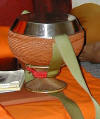|
alms bowl
Container used
by Buddhist monks to
collect alms, rounded in shape and usually made of metal. Alms bowls have been in use for over 2,500
years and are still so today, for early morning
bintabaat or
alms-gathering by monks (fig.).
It part of the
borikaan, i.e.
eight articles Buddhist monks are permitted to have for daily life. The process of alms bowl making is time-consuming allowing only a couple of
bowls a day to be completed, though the entire process for each alms bowl to complete takes about five days. It can weigh around two kilos and is assembled of eight pieces of metal,
representing the eight spokes of the
dhammachakka, the
Buddhist Wheel of Law, and the
Eightfold Path
(fig.).
A first metal strip is beaten into a circular form to make the rim. Then three
pieces are beaten to form a cross-like convex framework, with four triangular
pieces fitting in to complete the sides. The bowl is then welded in a kiln and
shaped. Afterwards it is repeatedly rubbed smooth and heated again to make its
surface gleam (fig.).
In Thai, they are called
baat and they can be
covered with a lid called
fah baat. It is generally carried in a
talokbaat, a removable bag with shoulder strap. It can also be placed on a stand, usually woven from thinly cleaved rattan-like
bamboo sticks and strips called tok, and referred to as kha baat (ขาบาตร). Many new alms bowls are mass-produced, but traditional handmade alms bowls are still made today in Bangkok's Ban Baat or ‘Alms Bowl Village’,
off Bamrung Meuang Road in Pomprap Sattruphai district, where this fading craft has been passed down over generations. Here, different styles of bowls of varied complexity are produced, i.e. the original and traditionally rather angular shaped baat song thai deum, i.e. ‘old-shaped Thai alms bowl’; the compressed, flat-bottomed, old-style baat song
takoh, i.e. ‘persimmon (fig.)-shaped alms bowl’; the rounded baat song
manao, i.e. ‘lemon-shaped alms bowl’; the small, low-rimmed
baat song look chan, i.e. ‘Gold Apple-shaped alms bowl’; and baat song hua seua, i.e. ‘tiger head (fig.)-shaped alms bowl’, with a cutback base, that allows for it to be placed on the floor. Whereas the first two models have been in use for centuries, the
manao and look chan styles have been in use for around 90 years, while the newest tiger head model has been in use for about 30 years only. Alms bowl are sometimes called
begging-bowl. See also
kapala and
tiab.
See also THEMATIC STREET LIGHT.
回






|

